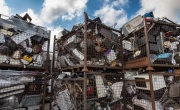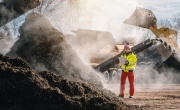Havering Council faces legal action over Arnold’s Field contamination dispute
High Court hears judicial review from Clear The Air In Having over council’s refusal to classify illegal landfill site as contaminated, despite threat to local health.

The legal challenge, launched in September 2024, focuses on the council’s determination that the site in Rainham, which has experienced over 100 fires in the past five years, does not meet the legal criteria for contaminated land status.
The residents, represented by law firm Mishcon de Reya, have argued that the site demonstrably causes significant harm to both human health and the environment due to the persistent fires and various contaminants.
A ‘contaminated land’ designation would legally obligate both the council and the Environment Agency to take specific action to ensure the site is cleaned up, either by the landowner, DMC (Essex) Ltd., or by the council itself, with reimbursement.
Discussing the legal action, Emily Nicholson, Partner at Mischon de Reya, said: “The grounds of challenge raise important points of law on how public authorities approach decision making in relation to environmental and public health issues, especially around air pollution and contaminated land, and we welcome the opportunity to address the Court on these issues."
Contamination in Arnold’s Field
The site, which was originally a gravel pit, has become the target of extensive illegal dumping, with estimates suggesting that between 30,000 and 40,000 cubic metres of unregulated waste was deposited there over a decade ago.
Frequent fires began erupting at the site with a noticeable increase in 2013. The London Fire Brigade has responded to the site with alarming frequency - more than 224 site visits since 2010.
These fires release toxic fumes into the surrounding air, directly exposing local residents and causing significant public concern regarding both short-term and long-term health implications.
Environmental investigations have revealed concerning levels of contaminants at the side. Soil samples from December 2023 showed the presence of lead with concentrations reaching 4400 mg/kg in the northern part of the site, significantly exceeding public open space screen criteria.
Asbestos-containing materials were identified on the surface and in shallow soils. Water and leachate samples also showed elevated levels of arsenic, mercury, organic compounds, and non-metals such as boron and chloride.
The site also produces dangerous levels of ground gases, with methane levels recorded as high as 33.4 per cent and carbon dioxide reaching 30.2 per cent in some areas. Havering Council notes that this could affect anyone using the site in the future, if it is developed for housing or industrial use.
Legal action against Havering Council
Havering Council has taken measures in response to the persistent issues at Arnold’s Field. These include commissioning investigations to assess potential health risks, establishing a technical group to guide the health risk assessment process, issuing air quality reports, and holding public meetings.
The council issued a statutory nuisance abatement notice and a community protection warning to the landowner, DMC (Essex) Ltd., who acquired the site in 2017.
However, the council has faced significant criticism for its decision to not formally designate the site as ‘contaminated land’. According to Mischon de Reya, the council also withdrew the notice from the landowner, accepting verbal commitments instead.
In a statement released on 14 March, councillor Ray Morgon, leader of Havering Council, issued a warning that the steps towards abatement need to be taken by the end of April 2025, or the council will re-serve the notice.
Morgon also defended the council’s actions, stating: “This administration has taken more action on Launders Lane since it took over the Council, than the previous administration did in 10 years. However, as we have stated a number of times, this is not Council-owned land, so our options are limited."
Morgon emphasised that the council is "now at a point where we have done all we can and are calling on urgent support from the Mayor of London, GLA and the government to intervene to resolve this crisis and put a stop to the fires once and for all."
Despite the ongoing legal challenge, the council has expressed willingness to collaborate with the landowner on planning applications for measures such as capping the landfill and installing perimeter fencing to enhance safety and prevent unauthorised access.








